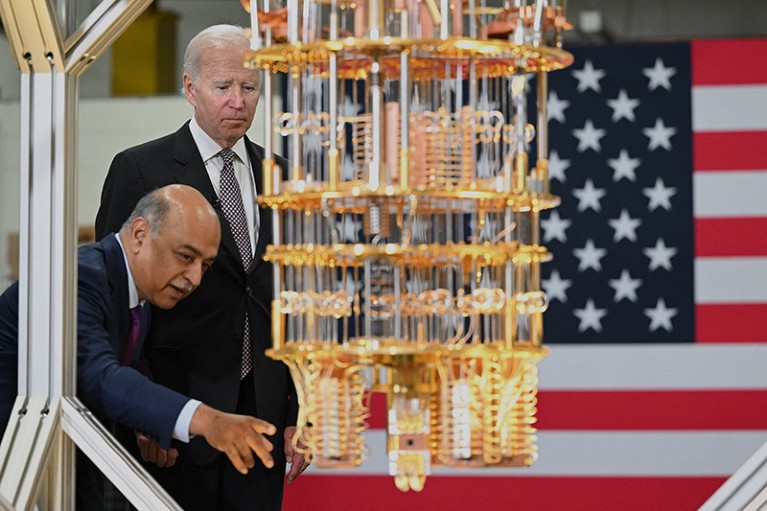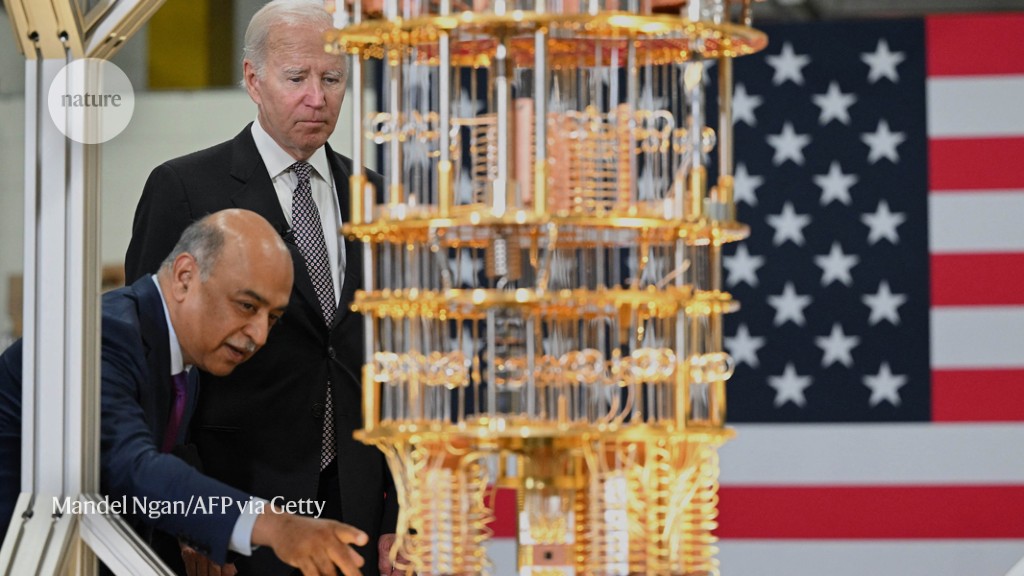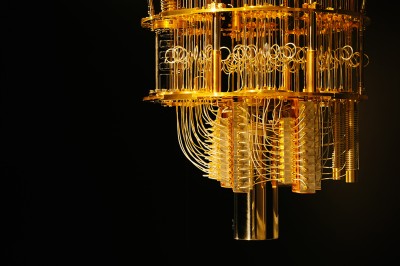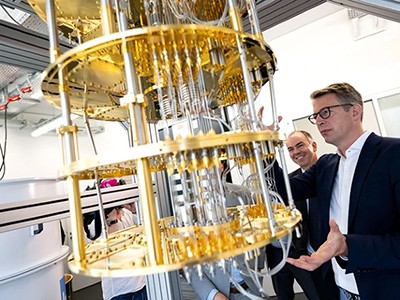
US president Joe Biden and IBM CEO Arvind Krishna examine a quantum computer at the company’s facility in Poughkeepsie, New York.Credit: Mandel Ngan/AFP via Getty
Four years ago, physicists at Google claimed their quantum computer could outperform classical machines — although only at a niche calculation with no practical applications. Now their counterparts at IBM say they have evidence that quantum computers will soon beat ordinary ones at useful tasks, such as calculating properties of materials or the interactions of elementary particles.
In a proof-of-principle experiment described in Nature on 14 June1, the researchers simulated the behaviour of a magnetic material on IBM’s Eagle quantum processor. Crucially, they managed to work around quantum noise — the main obstacle for this technology because it introduces errors in calculations — to get reliable results.
Underdog technologies gain ground in quantum-computing race
Their ‘error-mitigating’ techniques enabled the team to do quantum calculation “at a scale where classical computers will struggle”, says Katie Pizzolato, who heads IBM’s quantum theory group in Yorktown Heights, New York.
Although the problem they attacked uses a much-simplified, unrealistic model of a material, “It makes you optimistic that this will work in other systems and more complicated algorithms,” says John Martinis, a physicist at the University of California, Santa Barbara, who led the Google team to their 2019 milestone.
Sabrina Maniscalco, chief executive of quantum-computing start-up Algorithmiq in Helsinki, says that the experiment provides a benchmark for the state-of-the-art in quantum computers. “These machines are coming,” she says. Maniscalco’s company is developing algorithms for quantum-chemistry calculations that use error mitigation.
Uniquely quantum
Quantum computers employ peculiarly quantum phenomena, such as the ability of an object to exist in a simultaneous ‘superposition’ of two states, and of multiple objects to share a common quantum state, in what physicists call entanglement. Qubits are the quantum equivalent of the bits of ordinary computers, and can be in a superposition of the ‘0’ and ‘1’ states and be entangled with one another.
Physicists have been experimenting with a range of hardware for building quantum computers, including traps for individual ions or neutral atoms. IBM’s approach — which is also used by Google and other companies — encodes each qubit in a tiny superconducting circuit. For quantum computers to be effective, the qubits have to keep their quantum state for long enough for a calculation to be carried out. So a crucial engineering effort went into increasing the lifetime of the qubits, the IBM team says.
Quantum computers: what are they good for?
In the latest paper, IBM physicist Abhinav Kandala and his collaborators conducted precise measurements of the noise in each of their qubits, which can follow relatively predictable patterns determined by their position inside the device, microscopic imperfections in their fabrication and other factors. Using this knowledge, the researchers extrapolated back to what their measurements — in this case, of the full state of magnetization of a two-dimensional solid — would look like in the absence of noise. They were then able to run calculations involving all of Eagle’s 127 qubits and up to 60 processing steps — more than any other reported quantum-computing experiment.
Error approach
Martinis says that the results validate IBM’s short-term strategy, which aims to provide useful computing by mitigating, as opposed to correcting, errors. Over the longer term, IBM and most other companies hope to shift towards quantum error correction, a technique that will require large numbers of additional qubits for each data qubit. (Google’s strategy has focused on refining quantum error-correction techniques.)
Some researchers are less optimistic about the potential of noise mitigation, and expect that only quantum error correction will enable calculations that would be impossible on even the largest classical supercomputers2.
The Eagle has 127 qubits — but IBM expects to unveil its most powerful processor yet, the 1,121-qubit Condor chip, later this year. The company also has “utility-scale processors” with up to 4,158 qubits in its development pipeline, says Jay Gambetta, head of IBM’s quantum-technology efforts. He adds that to achieve the longer-term goal of building 100,000-qubit machines that can do fully error-corrected algorithms by 2033, researchers will need to solve substantial engineering problems.








More News
US funders to tighten oversight of controversial ‘gain-of-function’ research
Bird flu in US cows: where will it end?
Daily briefing: Why exercise is good for us